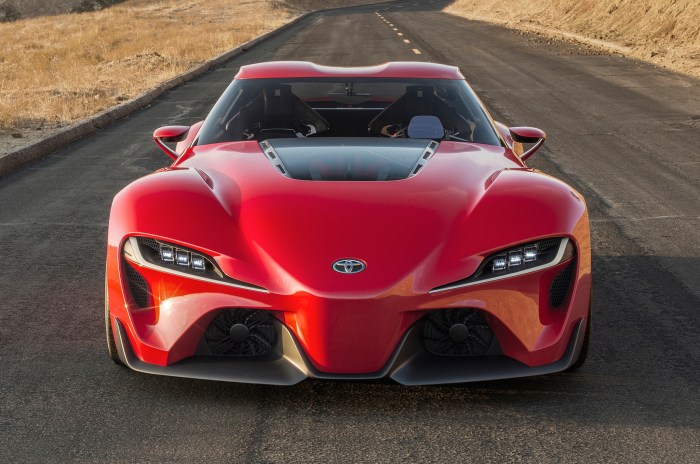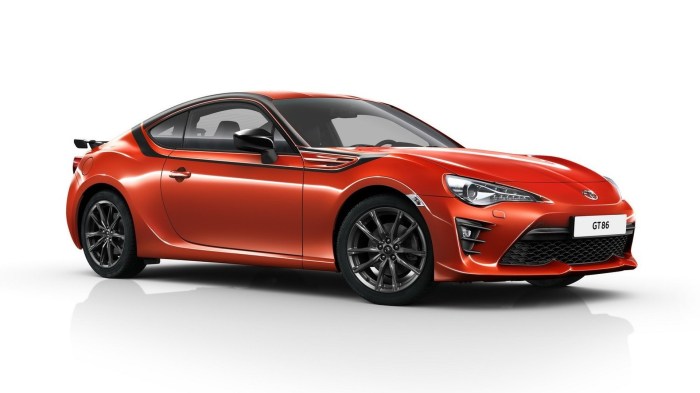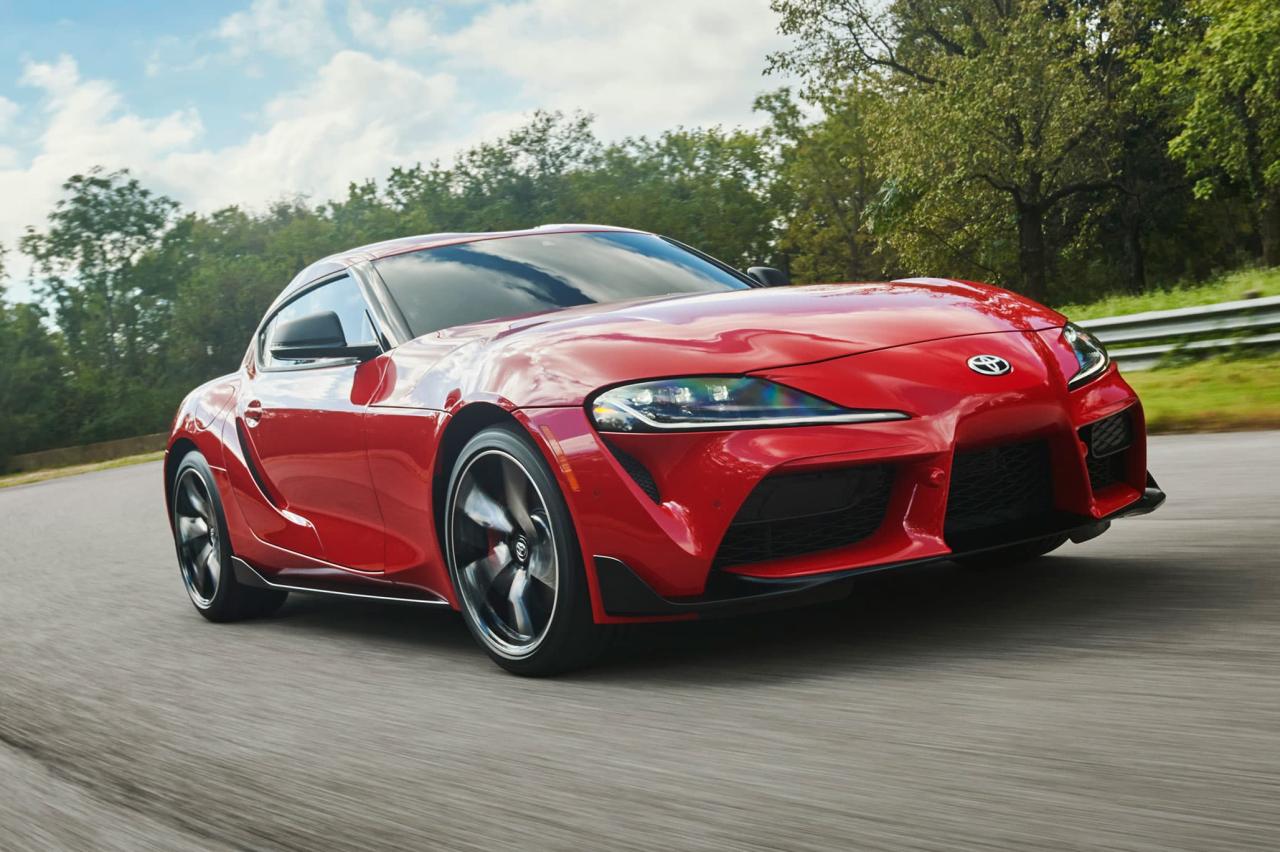Toyota Sports Car Models: From the legendary Celica to the modern GR Supra, Toyota’s foray into the world of sports cars boasts a rich history filled with iconic designs and groundbreaking engineering. This exploration delves into the evolution of these performance machines, examining their design philosophies, technological advancements, and cultural impact.
We’ll compare popular models, analyze their strengths and weaknesses, and even look at their starring roles in motorsport and popular culture.
We’ll cover key models like the Supra, MR2, Celica GT-Four, and the 86 (GT86/Scion FR-S/Subaru BRZ), comparing their performance, handling, and target audiences. We’ll also examine the engineering behind their success, from aerodynamic design to engine technology and chassis construction.
Get ready for a deep dive into the world of Toyota’s high-performance legacy.
Historical Overview of Toyota Sports Cars: Toyota Sports Car Models
Toyota’s foray into the sports car market wasn’t an immediate success story, but rather a gradual evolution reflecting changing market demands and technological advancements. From humble beginnings, they’ve built a reputation for reliable, well-engineered sports cars, often undercutting competitors on price while delivering respectable performance.
This journey showcases a fascinating blend of Japanese engineering prowess and a shrewd understanding of the global automotive landscape.
Toyota’s Early Sports Car Efforts and the 2000GT
Toyota’s initial attempts at sports car production were relatively modest, focusing on smaller, more affordable models. However, the 1967 Toyota 2000GT marked a significant turning point. This stunning GT car, co-developed with Yamaha, showcased Toyota’s ambition and capability, boasting a powerful inline-six engine and elegant design.
Its appearance in the James Bond film “You Only Live Twice” cemented its place in automotive history. This model established a foundation for Toyota’s future sports car endeavors, demonstrating that they could compete on the world stage with established players.
The AE86 Corolla Levin/Sprinter Trueno and the Rise of Affordable Performance
The late 1970s and 1980s saw the arrival of the legendary Toyota Corolla Levin/Sprinter Trueno (AE86). This front-engine, rear-wheel-drive coupe, despite its relatively small engine, quickly gained a cult following for its nimble handling and exceptional balance. Its lightweight design and responsive nature made it ideal for drifting and motorsport, contributing significantly to the car’s enduring legacy and becoming a cornerstone of affordable performance.
The AE86’s influence on the automotive world, particularly within the drifting community, remains profound.
Technological Advancements and the MR2
The introduction of the MR2 (mid-engine, rear-wheel-drive) in 1984 represented a significant shift in Toyota’s sports car strategy. This innovative layout offered exceptional handling and balance, showcasing Toyota’s willingness to experiment with unconventional designs. Subsequent generations of the MR2 incorporated increasingly sophisticated technologies, including turbocharging and advanced suspension systems, enhancing performance and driving dynamics.
The MR2’s success solidified Toyota’s position as a serious contender in the sports car segment, demonstrating their ability to create engaging, technologically advanced vehicles.
The Supra’s Reign and the Evolution of High-Performance
The Toyota Supra, first introduced in 1978, evolved into a high-performance icon over its multiple generations. Each iteration showcased improvements in engine technology, aerodynamics, and handling. The fourth-generation A80 Supra, particularly the turbocharged variants, achieved legendary status for its raw power, refined handling, and iconic styling.
The Supra’s success highlighted Toyota’s commitment to producing truly high-performance vehicles capable of competing with the best from Europe and the United States. Its advanced engine technology, including twin-turbocharging in later models, pushed the boundaries of performance for its class.
Timeline of Major Milestones in Toyota Sports Car History
| Model Name | Year | Key Features | Significance |
|---|---|---|---|
| Toyota 2000GT | 1967 | Inline-six engine, elegant design, James Bond appearance | Established Toyota’s presence in the high-performance market |
| Corolla Levin/Sprinter Trueno (AE86) | 1983 | Lightweight, rear-wheel-drive, nimble handling | Cult following, significant influence on drifting culture |
| MR2 | 1984 | Mid-engine, rear-wheel-drive, innovative layout | Showcased Toyota’s commitment to advanced engineering |
| Supra (A80) | 1993 | Twin-turbocharged engine, advanced aerodynamics, high performance | Became a legendary high-performance icon |
Popular Toyota Sports Car Models
Toyota’s legacy in the sports car market is undeniable, boasting a diverse lineup that caters to various driving styles and preferences. This section delves into a comparative analysis of four iconic models: the Supra, MR2, Celica GT-Four, and the 86 (also known as the GT86, Scion FR-S, and Subaru BRZ).
We’ll examine their target audiences, strengths, and weaknesses across key performance metrics.
Toyota Sports Car Model Comparison
The following table provides a concise overview of the four models, highlighting key differences in engine specifications, handling, and notable features. This comparison allows for a clearer understanding of each model’s unique characteristics and the driving experience they offer.
| Model | Engine Specs (Example: Year, Engine Type, Horsepower) | Handling Characteristics | Notable Features |
|---|---|---|---|
| Supra (A80 generation, for example) | 1993-1998, 3.0L Inline-6, 220-320 hp (depending on trim) | Precise steering, balanced chassis, powerful acceleration. Known for its rear-wheel drive handling, which can be challenging for less experienced drivers. | Iconic styling, legendary status, powerful engine, advanced technology for its time (e.g., active suspension in some models). |
| MR2 (AW11 generation, for example) | 1984-1989, 1.6L Inline-4, ~112 hp | Agile and nimble handling, lightweight design, rear-wheel drive (early models) or mid-engine rear-wheel drive (later models). Excellent for twisty roads. | Mid-engine layout, compact size, fuel efficiency (relatively speaking), affordability. |
| Celica GT-Four (ST185 generation, for example) | 1990-1994, 2.0L Turbocharged Inline-4, ~240 hp | All-wheel drive provided excellent grip and stability, especially in challenging conditions. Could be slightly less agile than the MR2 but offered superior traction. | All-wheel drive, turbocharged engine, rally heritage, advanced suspension systems. |
| 86 (GT86/Scion FR-S/Subaru BRZ) | 2.0L Boxer-4, ~200 hp | Rear-wheel drive, balanced handling, focus on driver engagement. Lightweight design contributes to its responsiveness. | Affordable price point, exceptional handling balance, naturally aspirated engine, driver-focused design. Shares platform and many components with the Subaru BRZ. |
Target Audiences
Each model attracted a specific target audience based on its features and performance. The Supra, with its powerful engine and iconic status, appealed to experienced drivers seeking high performance and a classic sports car experience. The MR2, due to its compact size and nimble handling, attracted drivers who valued agility and fuel efficiency.
The Celica GT-Four, with its all-wheel drive and rally heritage, targeted drivers who needed or desired superior grip and all-weather capability. Finally, the 86, with its affordable price and focus on driver engagement, aimed for a younger audience or enthusiasts looking for a fun, accessible sports car.
Strengths and Weaknesses
While each model excelled in certain areas, they also had limitations. The Supra’s power and handling were offset by its relatively high price and fuel consumption. The MR2’s agility was sometimes balanced against limited passenger and cargo space. The Celica GT-Four’s all-wheel drive enhanced stability but could impact its agility compared to rear-wheel drive counterparts.
The 86’s affordability and handling were balanced by its relatively low horsepower. These trade-offs are common in sports car design, where priorities often need to be balanced.
Design and Engineering Aspects of Toyota Sports Cars

Toyota’s foray into the sports car market showcases a blend of performance-oriented design and innovative engineering. Their approach often prioritizes a balance between exhilarating driving dynamics and everyday practicality, a hallmark of the brand’s philosophy. This section delves into the key design and engineering elements that define Toyota’s sports cars.
Aerodynamic Design Elements, Toyota sports car models
Aerodynamic efficiency is crucial for high-performance vehicles, impacting both speed and fuel economy. Toyota employs several design elements to minimize drag and maximize downforce in its sports cars. These include sculpted bodywork with smooth surfaces to reduce air resistance, integrated spoilers and diffusers to manage airflow and create downforce, and carefully designed underbody panels to minimize turbulence.
For instance, the Toyota GR Supra’s low, wide stance and meticulously shaped body contribute significantly to its aerodynamic performance. The design minimizes lift at high speeds, enhancing stability and grip.
Engine Choices and Engineering
Toyota’s sports cars utilize a range of engine types, each chosen to meet specific performance goals. Naturally aspirated engines, known for their smooth power delivery and linear response, are featured in some models, offering a rewarding driving experience. Turbocharged and supercharged engines provide increased power and torque, enhancing acceleration and overall performance, as seen in the GR Yaris’s powerful turbocharged three-cylinder.
Hybrid powertrains, while less common in pure sports cars, offer a unique blend of performance and efficiency, representing Toyota’s commitment to innovative technology. The engineering choices often consider factors such as weight, power-to-weight ratio, and emissions regulations.
Chassis Design and Handling
The chassis is the backbone of any sports car, significantly impacting handling and performance. Toyota employs various chassis designs, often incorporating lightweight materials like aluminum or high-strength steel to optimize weight distribution and enhance responsiveness. The choice of suspension system – independent setups are common – plays a vital role in providing precise handling and comfortable ride quality.
Toyota engineers carefully tune the suspension components (springs, dampers, anti-roll bars) to achieve the desired balance between agility and stability. For example, the GR86 prioritizes a lightweight and balanced chassis design, contributing to its renowned fun-to-drive character.
Toyota Sports Car Drivetrain: Conceptual Diagram
Engine: Provides the power to propel the vehicle. This could be a gasoline engine, a hybrid powertrain, or even an electric motor.
Transmission: Transfers power from the engine to the wheels, allowing for different gear ratios to optimize performance at various speeds. This could be a manual, automatic, or continuously variable transmission (CVT).
Driveshaft (if applicable): Connects the transmission to the differential in rear-wheel-drive or all-wheel-drive vehicles. Transmits rotational power.
Differential: Distributes power between the rear (or front and rear) wheels, allowing them to rotate at different speeds during turns.
Axles: Connect the differential to the wheels, transferring power and enabling rotation.
Wheels and Tires: Provide the final interface between the vehicle and the road, translating engine power into motion.
Toyota Sports Cars in Motorsport

Toyota’s foray into motorsport isn’t just a marketing exercise; it’s a crucial part of their engineering and design philosophy. The intense demands of racing push the boundaries of automotive technology, forcing innovations that ultimately find their way into road-going models, enhancing performance, reliability, and safety.
This commitment to competition has shaped Toyota’s sports car legacy, resulting in both iconic vehicles and impressive achievements on the track.Toyota’s motorsport involvement spans several decades and various disciplines, most notably endurance racing. The company’s participation in these high-profile events provides a rigorous testing ground, pushing their engineering teams to solve complex problems under extreme conditions.
This translates directly to improvements in the reliability and performance of their production sports cars. The learnings gained from pushing vehicles to their absolute limits on the track directly inform the design and development of road-going models, improving everything from engine performance and handling to braking systems and aerodynamics.
Toyota’s Participation in Major Motorsport Events
Toyota’s most significant motorsport commitment is undoubtedly its participation in the World Endurance Championship (WEC), culminating in their dominance at the 24 Hours of Le Mans. Their TS050 Hybrid, a technological marvel showcasing their hybrid expertise, achieved multiple victories and overall wins.
Beyond Le Mans, Toyota has also competed in other prestigious events, demonstrating their prowess across various racing disciplines. Their involvement in rallying, through the Celica GT-Four and Corolla WRC, also showcased their engineering capabilities and resulted in numerous championship wins.
The company’s participation in NASCAR, though less directly related to their sports car lineage, further demonstrates their commitment to competitive motorsport.
Modifications for Racing Purposes
Transforming a road-going sports car into a competitive race car requires extensive modifications. These changes go far beyond simple aesthetic upgrades. For instance, race cars often feature significantly lighter weight chassis, achieved through the use of carbon fiber and other lightweight materials.
Engines are heavily modified, with increased displacement, enhanced breathing, and upgraded components to dramatically increase horsepower and torque. Aerodynamics are meticulously refined through extensive wind tunnel testing, resulting in aggressive body kits designed to maximize downforce and minimize drag.
Suspension systems are tuned for optimal handling and responsiveness on the track, while braking systems are upgraded to withstand the extreme stresses of high-speed racing. Safety features, including roll cages and advanced fire suppression systems, are also critical modifications.
Impact of Motorsport Success on Road-Going Models
The lessons learned from motorsport directly influence the development of Toyota’s road-going sports cars. Advances in engine technology, aerodynamics, materials science, and chassis design, all honed on the track, often find their way into production vehicles. For example, the hybrid technology developed for the TS050 Hybrid has influenced the development of hybrid powertrains in road cars, improving fuel efficiency and performance.
Similarly, advancements in lightweight materials and aerodynamics contribute to improved handling, fuel economy, and overall performance in production sports cars. The rigorous testing and development process inherent in motorsport helps ensure the reliability and durability of Toyota’s road cars.
Notable Victories and Achievements
The success of Toyota sports cars in motorsport is undeniable. A list of their notable achievements includes:
- Multiple overall victories at the 24 Hours of Le Mans (with the TS050 Hybrid and GR010 Hybrid).
- Numerous wins and championship titles in the World Rally Championship (WRC) with the Celica GT-Four and Corolla WRC.
- Significant success in various other endurance racing series worldwide.
- Continuous development and improvement of hybrid technology showcased through their participation in WEC.
Cultural Impact and Legacy of Toyota Sports Cars

Toyota’s sports cars, while perhaps not holding the same iconic status as some European counterparts, have nonetheless carved a significant niche in automotive culture, impacting popular perception and leaving a lasting legacy. Their influence extends beyond mere performance figures, shaping trends and inspiring generations of drivers.
This impact stems from a combination of accessible performance, reliable engineering, and strategic appearances in popular media.Toyota sports cars haven’t just been about speed; they’ve represented a specific ideal of attainable performance and style. Unlike some high-end exotics, Toyota’s offerings have often been within reach for a wider segment of the population, fostering a strong sense of community among owners and enthusiasts.
This accessibility has been a key factor in their lasting cultural impact.
Toyota Sports Cars in Popular Culture
The presence of Toyota sports cars in movies and video games has significantly contributed to their cultural footprint. These appearances often portray them as reliable, stylish, and capable vehicles, sometimes even as symbols of youthful rebellion or determined protagonists.
The cars themselves become characters in the narrative, enhancing the visual appeal and even influencing the plot. For instance, the consistent appearance of various Supra models in theFast and Furious* franchise significantly boosted the car’s popularity and cemented its place in pop culture.
The image of the Supra drifting, its iconic body lines emphasized by the camera angles and dramatic lighting, is now almost synonymous with the franchise itself.
The Lasting Legacy of Toyota’s Sports Car Heritage
The legacy of Toyota’s sports cars is one of consistent evolution and a dedication to pushing the boundaries of performance within the context of reliable, mass-produced vehicles. The Supra, Celica, and MR2 all represent distinct eras and design philosophies, but share a common thread of sporty handling, engaging driving dynamics, and a relatively accessible price point.
This heritage continues to inspire modern designs and informs the development of future models, ensuring that the spirit of Toyota’s sports car legacy lives on. The impact is evident in the highly anticipated return of the Supra and the ongoing development of exciting new sports car technologies within the company.
A Memorable Toyota Sports Car Scene
One particularly memorable scene featuring a Toyota sports car is the initial chase sequence in2 Fast 2 Furious*. The vibrant, sun-drenched Miami setting provides a striking backdrop to the high-octane action. Brian O’Conner (Paul Walker), driving a modified Toyota Supra, navigates the crowded streets, effortlessly weaving through traffic and performing impressive drifts.
The camera angles are dynamic, emphasizing the Supra’s agility and speed. The vibrant colors of the cars and the city, combined with the adrenaline-pumping music, create a visually stunning and unforgettable sequence that perfectly encapsulates the thrill and excitement associated with Toyota sports cars.
The sleek lines of the Supra are highlighted, particularly in shots emphasizing its powerful engine and customized body kit. The scene’s overall effect is one of exhilarating energy and stylish action, firmly placing the Toyota Supra within the realm of cinematic icons.
Wrap-Up
Toyota’s sports car legacy is a testament to their commitment to innovation and performance. From humble beginnings to global motorsport success, these cars have captivated enthusiasts for decades. Their impact extends beyond the track and into popular culture, cementing their place in automotive history.
Whether you’re a seasoned car aficionado or a curious newcomer, the story of Toyota sports cars is one that deserves to be told and celebrated.
FAQ Summary
What is the difference between the GT86 and the Supra?
The GT86 is a smaller, more affordable, and lighter sports coupe focusing on balanced handling. The Supra is a larger, more powerful, and luxurious grand tourer prioritizing straight-line speed and performance.
Are Toyota sports cars reliable?
Toyota generally has a reputation for reliability, and their sports cars are no exception, although, like any performance vehicle, maintenance needs will be higher than average cars.
Which Toyota sports car is best for beginners?
The Toyota 86/GT86 is often recommended for beginners due to its relatively manageable power, rear-wheel-drive handling characteristics (good for learning), and affordability.
What is the future of Toyota sports cars?
Toyota is committed to performance vehicles, evidenced by the GR line of performance models. Expect continued evolution and innovation in this segment, potentially with electrification playing a larger role.